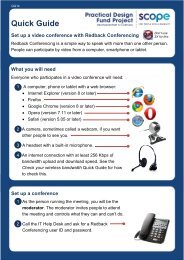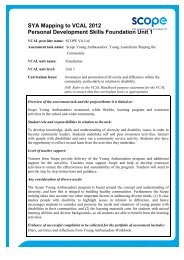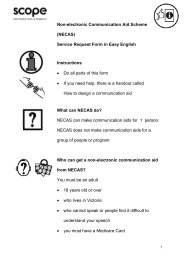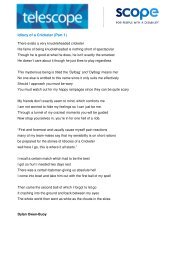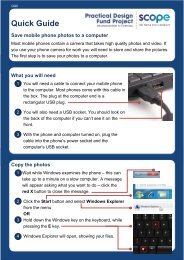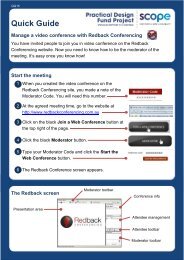Positive behaviour support Getting it right from the start
Positive behaviour support Getting it right from the start
Positive behaviour support Getting it right from the start
You also want an ePaper? Increase the reach of your titles
YUMPU automatically turns print PDFs into web optimized ePapers that Google loves.
<strong>Pos<strong>it</strong>ive</strong> <strong>behaviour</strong> <strong>support</strong>: <strong>Getting</strong> <strong>it</strong> <strong>right</strong> <strong>from</strong> <strong>the</strong> <strong>start</strong> - Facil<strong>it</strong>ators reference manual 83<br />
Strategy<br />
Encourage relaxation<br />
Do something completely unexpected<br />
Example of how <strong>it</strong> may be used<br />
1. Acknowledge that <strong>the</strong> person is upset.<br />
2. Instruct <strong>the</strong> person to calm down.<br />
3. Instruct <strong>the</strong> person in activ<strong>it</strong>ies that promote<br />
relaxation (Soles of <strong>the</strong> feet, deep breathing, music,<br />
etc).<br />
4. Leave <strong>the</strong> s<strong>it</strong>uation, if necessary, where <strong>the</strong>y can<br />
remain undisturbed.<br />
5. When <strong>the</strong>y arrive, try to help <strong>the</strong>m to get<br />
comfortable and relaxed. Encourage <strong>the</strong> person<br />
throughout.<br />
Sing a song loudly.<br />
Response is usually only momentary but allows<br />
time to evade.<br />
The surprise will wear off if <strong>it</strong> is used repeatedly.<br />
Inter-pos<strong>it</strong>ioning<br />
Paul, who weighs about 90kg, rushes towards a staff<br />
member w<strong>it</strong>h his hands in <strong>the</strong> air. The staff member<br />
pos<strong>it</strong>ions herself behind a table and uses ‘active<br />
listening’.<br />
Barry runs <strong>from</strong> <strong>the</strong> k<strong>it</strong>chen table towards <strong>the</strong> front<br />
door of his house which fronts a busy street. Staff<br />
pos<strong>it</strong>ion <strong>the</strong>mselves between him and <strong>the</strong> door and<br />
speak loudly enough to distract his focus.<br />
Example immediate response strategy plan<br />
These strategies are designed to defuse or de-escalate a potentially serious episode<br />
of <strong>the</strong> <strong>behaviour</strong> when <strong>the</strong> warning signs are apparent, or to manage a serious episode<br />
when <strong>it</strong> occurs. Reactive strategies are NOT designed to bring about long-term<br />
<strong>behaviour</strong> change.<br />
The diagram below is commonly known as <strong>the</strong> stress or anger cycle. It represents a<br />
series of phases that can be observed as people escalate in <strong>the</strong> degree of aggressive or<br />
ag<strong>it</strong>ated <strong>behaviour</strong>. Following is a list of <strong>the</strong> known activ<strong>it</strong>ies and s<strong>it</strong>uations that trigger<br />
<strong>the</strong> person’s <strong>behaviour</strong>, and also those <strong>behaviour</strong>s or warning signs that can at times be<br />
seen prior to a serious episode occurring. This list aims to provide people <strong>support</strong>ing <strong>the</strong><br />
person w<strong>it</strong>h an observation strategy that enables <strong>the</strong>m to intervene as early as possible in<br />
<strong>the</strong> <strong>behaviour</strong> cycle.<br />
Phase 1. Phase 2. Phase 3. Phase 4. Phase 5<br />
Triggering event<br />
Escalation<br />
(warning signs)<br />
Crisis Recovery Post crisis<br />
depression




